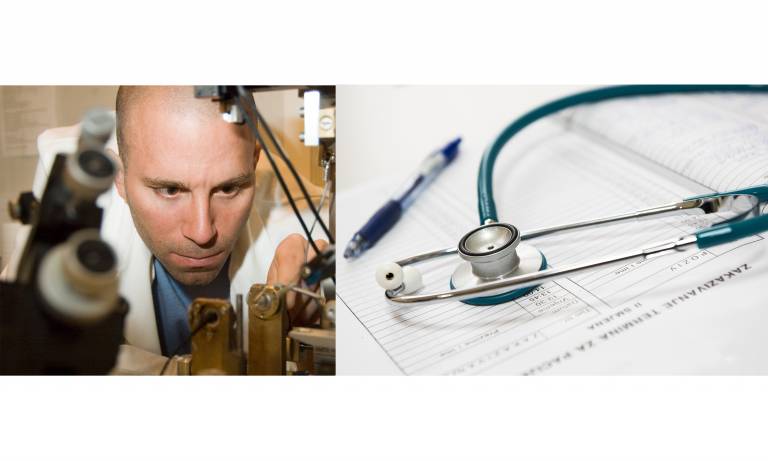Nick Lesica joins Mini MD programme
5 March 2020
Nick Lesica swapped the lab for the operating theatre as part of the Mini MD programme organised by the NIHR Hearing and Deafeness Theme and UCL's Knowledge Exchange

Nick Lesica, a professor and researcher at the Ear Institute, was able to spend a week at the Royal National Throat Nose and Ear Hospital observing clinics and surgical operations as part of the “Mini-MD” programme organized through the Hearing and Deafness theme of our Biomedical Research Centre.
It was a unique learning experience for a researcher more used to the quieter environs of the laboratory. When asked what he observed from a scientist's perspective, he relayed the following key lessons:
The middle ear is important!
This may be obvious to clinicians, but the middle ear is ignored by many scientists. This clearly needs to change as there are a number of pressing clinical questions that scientists may be able to help answer: How can bone-based devices for conductive hearing loss be optimized to provide a more natural auditory experience? What is best way to integrate bone-based devices with other devices (e.g. traditional hearing aids) for patients with asymmetric hearing loss? How does long-term conductive hearing loss impact central auditory processing?
Hearing and balance are linked!
Another disconnect between the clinic and research arises from the fact that many scientists consider hearing and balance separately (that is, of course, if they consider balance at all). In reality, they are inextricably linked and clinicians use this link to their advantage when making inferences about underlying pathologies or optimal treatments. There is a clear opportunity for research that considers the ear as a multi-sensory organ to better characterize the interactions between hearing and balance and make clinical inferences based on these links even more powerful.
There is no such thing as a typical patient!
This is often cited by clinicians as one of their biggest challenges, and actually seeing the variety of patients coming through over the course of a week really reinforced this point. Two very different patients -- for example, an older adult with sudden-onset profound deafness and a child with progressive hearing loss that is now severe -- might receive the same treatment: a cochlear implant. The outcome of the treatment will depend on complex interactions between the various dimensions of each patient’s history and the specifics of the treatment that they receive. But how can the specifics of the treatment be chosen in a principled way in the face of such overwhelming complexity? This is a question that science, particularly large-scale pre-clinical science, might be able to answer by providing insight into the interactions between patient history and treatment specifics that have the biggest impact on outcomes. There are, of course, many challenges to designing and conducting research of this nature, but it is definitely a path worth pursuing.
Clinicians work really hard!
Many scientists work a lot of hours. But there is an intensity to clinical work that is rare in science. It seems to be non-stop full-on for the entire day for everyone involved; it was tiring just to watch. In science, there is often very little structure to the day and there are few hard deadlines. We relish this flexibility because it affords us the time to think deeply about our science. But after watching the clinicians work, I can imagine how imposing more structure and urgency on science could help us to more clearly define the short-term steps required to reach our long-term goals and allow us to progress toward them more efficiently.
Links
NIHR Biomedical Research Centre Academic Careers Office
 Close
Close

